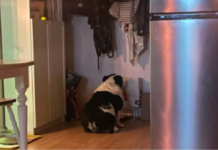Last Updated on October 29, 2023 by Fumipets
How to Potty Train a Goat: A Step-by-Step Guide for Clean and Hygienic Farming
Potty training a goat can be a useful endeavor for both pet and livestock owners. While goats are naturally inclined to defecate in specific areas, effective potty training can help reduce mess and maintain a cleaner living environment.
The process involves patience, consistency, and positive reinforcement. By designating a specific area for your goat to relieve itself, offering rewards for successful use of that area, and cleaning up accidents promptly, goats can learn to associate the chosen spot with potty time. With time and practice, potty training can make goat ownership more convenient and hygienic.
How to Potty Train a Goat:
Goats have a tremendous capacity for love and may form enduring ties with their owners. You may want to spend more time with your goats if you’ve developed a close relationship with them. You may think about teaching your goat to use the restroom inside your home all day.
However, goats prefer being outdoors since they need a lot of area to move about and investigate. The majority of goat specialists agree that 25 square feet per goat in a barn are a good amount, and they also require a lot of extra outside area for exercise. However, you may attempt toilet training your goat if you want to spend more time with it, particularly during the winter months.
Help your goat get house trained by following our detailed instructions so you can enjoy having them around the house.
Can Goats Be House Trained?
Goats that have been house trained will not resemble housebroken canines. Goats need a lot more area than dogs, which may live totally inside with you. So, much like a dog, it wouldn’t be ideal for them to live at home with you. You may, however, teach them to use the toilet so that they can briefly enter your home without causing too much chaos.
Goat toilet training is a rather simple operation. Goats, on the other hand, may take a while to figure it out. Although it will take a lot of patience, it is feasible. Here are some actions you may do to assist your goat in being toilet trained.
Before You Start
Remember that goats with spaying or neutering are more likely to become housebroken. This is so that the opposing sex won’t be attracted by the aroma that goats leave in their pee.
Furthermore, certain goat species make better home pets than others. The Pygmy goat and the Nigerian dwarf goat are small breeds that may adapt easily to entering a home. Larger popular breeds of goat, such as the Alpine, Saanen, and Nubian goat, often don’t make ideal house pets and don’t respond well to housebreaking.
It’s also important to remember that although goats can learn to urinate outdoors, they don’t always have excellent control over their waste. They won’t thus acquire the ability to defecate outdoors. Therefore, you may try placing a diaper on your goat if you don’t want feces in the home.
You may begin toilet training your goat if you’re okay with these preliminary concerns.
Greet Your Goat As Soon As It Wakes Up
Start the toilet training process outdoors, in the goat enclosure. Immediately after waking up and immediately after eating, goats often go potty. As a result, you wish to intercept them at certain times.
Start by noting the sleeping patterns of your goat. Normally, goats sleep for five hours at night and take many naps throughout the day.
Start approaching your goat at times when they are going to wake up after you have a basic understanding of their sleeping habits. When they awaken from their slumber, take them to the location you’ve designated as a bathroom. Ensure that this location is distant from their shelter or barn.
In order to prevent your goat from fleeing or thinking you want to play, always remember to approach slowly and gently. To prevent your goat from leaving the confines before going to the bathroom, you may fence off a space and keep it enclosed.
It’s OK if you skip a few naps since it’s hard to notice when your goat wakes up. Simply make an effort to say hello to them often during the day.
Take Your Goat Outside Right After It Finishes Drinking
By maintaining a habit of bottle feeding your child, you may assist with toilet training. They will need to urinate shortly after they have finished drinking from a bottle. Take your goat to a convenient place to empty itself, then wait until they are finished.
Reward Your Goats With Treats
Rewarding your goat is important. To help the command become associated with a good thing, provide a pleasant gift. In order to assist them make the connection between words or phrases and treats, you may also use positive phrases like “good boy.” With the use of this verbal signal, goats may be able to comprehend the benefits of using the restroom at the intended location more rapidly.
Direct your goat inside the home right after rewarding them. Their ability to make the connection that using the restroom outdoors results in inside time is aided by this behavior. You may speed up your goats’ potty-training by creating a regimen.
Gradually Increase Indoor Times
It’s essential to take preventive and anticipatory action. As a result, you shouldn’t allow your goat to urinate inside the home.
Allow your goat to remain inside for the first 15 to 20 minutes. Give your goat their favorite snacks and let them securely explore the interior area to make the experience more enjoyable. While they’re inside, you may also play games with them or gift them more pets.
You may start extending the period to 30 minutes after your goat can remain inside for an average of 15 minutes without having to go outside. Increase the time increments to 45 minutes and then an hour as soon as your goat successfully stays inside your house without going outside for 30 minutes.
Your goat will gradually learn the norms you’re attempting to set as you train it to relieve itself in certain locations and increase the amount of time it spends inside. Your goats will eventually learn to urinate anytime they need to go outdoors.

The Litter Box Method
Utilizing the litter box approach is one way to hasten your goat’s toilet training. You may collect urine-soaked hay in an elevated box to make a litter box the size of a goat.
You may put the sopped hay into the litter box if your goat poop outside of the box. Your goats may eventually begin to urinate in the same spot thanks to the aroma. Just be aware that this procedure will produce a powerful smell. Therefore, it’s critical to place the litter box away from your goat’s shelter and to clean the litter box on a regular basis.
Other Challenges With Potty Training a Goat
It’s difficult enough to teach a goat to use the toilet. There are a few more factors to take into account before you decide to educate your goat to use the restroom.
Goats Chew Everything
Goats are observant creatures that like exploring everything. They chew and taste objects as they investigate, among other things.
Your goat will find plenty of items to gnaw on within your home, including clothes and furniture. Owners of goats should never leave their animals alone in their houses. Goats may find and ingest too many hazardous materials, such as electrical lines and cleaning chemicals.
Goats Can Damage Floors and Furniture
Goats may harm property even if they don’t eat it because of their horns and hooves. You may anticipate noticing dents and scratches on your wood floors and tiles since goat hooves are robust and long-lasting. Scuff marks are also typical on carpeted flooring.
Larger goats could accidently bump into furniture and knock things over since they aren’t aware of their size and power.
Goat-Proofing Your House
It’s crucial to goat-proof your house because of the possible harm your goat might create and the hazards it could enter. It’s preferable to let your goat access certain portions of the house since it’s practically difficult to completely goat-proof the whole home.
Make careful to remove any devices and power wires from these locations. Eliminate any dangerous liquids, such as insecticides and cleaning solutions. A limited quantity of furniture or furniture that you don’t mind being scratched should also be present in these spaces.
Conclusion
Potty training your goat is extremely doable, but there are some restrictions. First off, your goat won’t be able to manage when they defecate and will only learn to urinate outdoors. In order for your goat to have designated safe spaces to dwell, you’ll also need to goat-proof some areas of your house. Remember that goats don’t thrive when kept indoors for the most of the day. As a result, they should consider spending some time inside as a pleasure.
Overall, having your goat live with you in your house is enjoyable and gratifying, and it may deepen your relationship with your goat. If you feel up to the task of toilet training a goat, always keep in mind that patience is the key. Consider your accomplishments rather than your failures.
Just be consistent in your training, and your goat will eventually figure it out. Once you’re ready to enjoy spending time inside together, you and your goat will quickly experience a fantastic and well-deserved feeling of success.
Questions and Answers:
At what age can you start potty training a goat?
Potty training can begin when a goat is a few weeks old, as they start developing control over their bowel movements. However, it may take some time for them to grasp the concept fully.
How can you designate a potty area for your goat?
You can use various methods to create a designated potty area, such as placing a litter box or using a specific corner of their enclosure. Make sure it’s easily accessible to the goat.
What rewards can be used for potty training goats?
Positive reinforcement is key. You can use small treats, verbal praise, or petting as rewards for goats when they use the designated potty area correctly.
Is potty training effective for all goats?
Potty training can be effective for many goats, but success may vary depending on the individual goat’s temperament and your consistency in training.
How should accidents be handled during potty training?
Accidents should be cleaned up promptly to prevent goats from returning to the soiled area. Use an odor-neutralizing cleaner to eliminate any residual scent. Continue training without punishment.


















